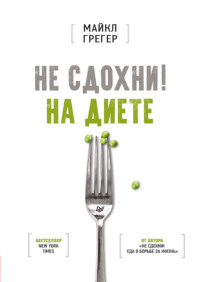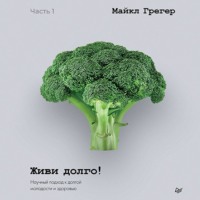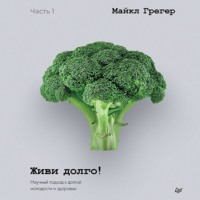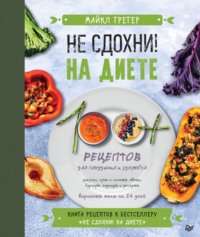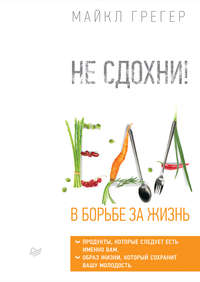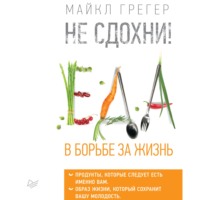
Полная версия
Живи долго! Научный подход к долгой молодости и здоровью
3652
Curry SJ, Krist AH, Owens DK, et al. Risk assessment for cardiovascular disease with nontraditional risk factors: US Preventive Services Task Force recommendation statement. JAMA. 2018;320(3):272–80. https://pubmed.ncbi.nlm.nih.gov/29998297/
3653
Diamond DM, de Lorgeril M, Kendrick M, Ravnskov U, Rosch PJ. Formal comment on “Systematic review of the predictors of statin adherence for the primary prevention of cardiovascular disease.” PLoS One. 2019;14(1):e0205138. https://pubmed.ncbi.nlm.nih.gov/30653537/
3654
Wei MY, Ito MK, Cohen JD, Brinton EA, Jacobson TA. Predictors of statin adherence, switching, and discontinuation in the USAGE survey: understanding the use of statins in America and gaps in patient education. J Clin Lipidol. 2013;7(5):472–83. https://pubmed.ncbi.nlm.nih.gov/24079289/
3655
Ward NC, Watts GF, Eckel RH. Statin toxicity: mechanistic insights and clinical implications. Circ Res. 2019;124(2):328–50. https://pubmed.ncbi.nlm.nih.gov/30653440/
3656
Zaleski AL, Taylor BA, Thompson PD. Coenzyme Q10 as treatment for statin-associated muscle symptoms – a good idea, but…. Adv Nutr. 2018;9(4):519S-23S. https://pubmed.ncbi.nlm.nih.gov/30032220/
3657
Banach M, Serban C, Sahebkar A, et al. Effects of coenzyme Q10 on statin-induced myopathy: a meta-analysis of randomized controlled trials. Mayo Clin Proc. 2015;90(1):24–34. https://pubmed.ncbi.nlm.nih.gov/25440725/
3658
Armour R, Zhou L. Outcomes of statin myopathy after statin withdrawal. J Clin Neuromuscul Dis. 2013;14(3):103–9. https://pubmed.ncbi.nlm.nih.gov/23492461/
3659
Majeed A, Molokhia M. Urgent need to establish the true incidence of the side effects of statins. BMJ. 2014;348:g3650. https://pubmed.ncbi.nlm.nih.gov/24920685/
3660
Finegold JA, Manisty CH, Goldacre B, Barron AJ, Francis DP. What proportion of symptomatic side effects in patients taking statins are genuinely caused by the drug? Systematic review of randomized placebo-controlled trials to aid individual patient choice. Eur J Prev Cardiol. 2014;21(4):464–74. https://pubmed.ncbi.nlm.nih.gov/24623264/
3661
Climent E, Benaiges D, Pedro-Botet J. Statin treatment and increased diabetes risk. Possible mechanisms. Clínica e Investigación en Arteriosclerosis. 2019;31(5):228–32. https://pubmed.ncbi.nlm.nih.gov/30737072/
3662
Mansi IA, English J, Zhang S, Mortensen EM, Halm EA. Long-term outcomes of short-term statin use in healthy adults: a retrospective cohort study. Drug Saf. 2016;39(6):543–59. https://pubmed.ncbi.nlm.nih.gov/26979831/
3663
The Panel on Food Additives and Nutrient Sources, Aggett P, Aguilar F, et al. Scientific opinion on the safety of monacolins in red yeast rice. EFSA J. 2018;16(80):5368. https://pubmed.ncbi.nlm.nih.gov/32626016/
3664
Gordon RY, Cooperman T, Obermeyer W, Becker DJ. Marked variability of monacolin levels in commercial red yeast rice products: buyer beware! Arch Intern Med. 2010;170(19):1722–7. https://pubmed.ncbi.nlm.nih.gov/20975018/
3665
Righetti L, Dall’Asta C, Bruni R. Risk assessment of RYR food supplements: perception vs. reality. Front Nutr. 2021;8:792529. https://pubmed.ncbi.nlm.nih.gov/34950692/
3666
Murphy SL, Kochanek KD, Xu J, Arias E. Mortality in the United States, 2020. NCHS Data Brief, No. 427. https://www.cdc.gov/nchs/products/databriefs/db427.htm. Published December 2021. Accessed January 3, 2023.; https://www.cdc.gov/nchs/products/databriefs/db427.htm
3667
Jukema JW, Cannon CP, de Craen AJM, Westendorp RGJ, Trompet S. The controversies of statin therapy: weighing the evidence. J Am Coll Cardiol. 2012;60(10):875–81. https://pubmed.ncbi.nlm.nih.gov/22902202/
3668
Newman CB, Preiss D, Tobert JA, et al. Statin safety and associated adverse events: a scientific statement from the American Heart Association. Arterioscler Thromb Vasc Biol. 2019;39(2):e38–81. https://pubmed.ncbi.nlm.nih.gov/30580575/
3669
Redberg RF, Katz MH. Statins for primary prevention: the debate is intense, but the data are weak. JAMA. 2016;316(19):1979–81. https://pubmed.ncbi.nlm.nih.gov/27838702/
3670
Ornish D, Scherwitz LW, Billings JH, et al. Intensive lifestyle changes for reversal of coronary heart disease. JAMA. 1998;280(23):2001–7. https://pubmed.ncbi.nlm.nih.gov/9863851/
3671
Kelly J, Karlsen M, Steinke G. Type 2 diabetes remission and lifestyle medicine: a position statement from the American College of Lifestyle Medicine. Am J Lifestyle Med. 2020;14(4):406–19. https://pubmed.ncbi.nlm.nih.gov/33281521/
3672
Esselstyn CB Jr, Gendy G, Doyle J, Golubic M, Roizen MF. A way to reverse CAD? J Fam Pract. 2014;63(7):356–64b. https://pubmed.ncbi.nlm.nih.gov/25198208/
3673
Hochholzer W, Giugliano RP. Lipid lowering goals: back to nature? Ther Adv Cardiovasc Dis. 2010;4(3):185–91. https://pubmed.ncbi.nlm.nih.gov/20400493/
3674
Steinberg D, Witztum JL. Inhibition of PCSK9: a powerful weapon for achieving ideal LDL cholesterol levels. Proc Natl Acad Sci U S A. 2009;106(24):9546–7. https://pubmed.ncbi.nlm.nih.gov/19506257/
3675
Cohen J, Pertsemlidis A, Kotowski IK, Graham R, Garcia CK, Hobbs HH. Low LDL cholesterol in individuals of African descent resulting from frequent nonsense mutations in PCSK9. Nat Genet. 2005;37(2):161–5. https://pubmed.ncbi.nlm.nih.gov/15654334/
3676
Jaworski K, Jankowski P, Kosior DA. PCSK9 inhibitors – from discovery of a single mutation to a groundbreaking therapy of lipid disorders in one decade. Arch Med Sci. 2017;13(4):914–29. https://pubmed.ncbi.nlm.nih.gov/28721159/
3677
Qamar A, Bhatt DL. Effect of low cholesterol on steroid hormones and vitamin E levels: just a theory or real concern? Circ Res. 2015;117(8):662–4. https://pubmed.ncbi.nlm.nih.gov/26405182/
3678
Blom DJ, Djedjos CS, Monsalvo ML, et al. Effects of evolocumab on vitamin E and steroid hormone levels: results from the 52-week, phase 3, double-blind, randomized, placebo-controlled DESCARTES study. Circ Res. 2015;117(8):731–41. https://pubmed.ncbi.nlm.nih.gov/26228031/
3679
Qamar A, Libby P. Low-density lipoprotein cholesterol after an acute coronary syndrome: how low to go? Curr Cardiol Rep. 2019;21(8):77. https://pubmed.ncbi.nlm.nih.gov/31250329/
3680
Hochholzer W, Giugliano RP. Lipid lowering goals: back to nature? Ther Adv Cardiovasc Dis. 2010;4(3):185–91. https://pubmed.ncbi.nlm.nih.gov/20400493/
3681
Glueck CJ, Gartside P, Fallat RW, Sielski J, Steiner PM. Longevity syndromes: familial hypobeta and familial hyperalpha lipoproteinemia. J Lab Clin Med. 1976;88(6):941–57. https://pubmed.ncbi.nlm.nih.gov/186545/
3682
Packard CJ. LDL cholesterol: How low to go? Trends Cardiovasc Med. 2018;28(5):348–54. https://pubmed.ncbi.nlm.nih.gov/29336946/
3683
Gotto AM. Low-density lipoprotein cholesterol and cardiovascular risk reduction: how low is low enough without causing harm? JAMA Cardiol. 2018;3(9):802–3. https://pubmed.ncbi.nlm.nih.gov/30073330/
3684
Packard CJ. LDL cholesterol: How low to go? Trends Cardiovasc Med. 2018;28(5):348–54. https://pubmed.ncbi.nlm.nih.gov/29336946/
3685
Steinberg D. The cholesterol controversy is over. Why did it take so long? Circulation. 1989;80(4):1070–8. https://pubmed.ncbi.nlm.nih.gov/2676235/
3686
Morgan DJ, Dhruva SS, Coon ER, Wright SM, Korenstein D. 2018 update on medical overuse. JAMA Intern Med. 2019;179(2):240–6. https://pubmed.ncbi.nlm.nih.gov/30508032/
3687
Lyu H, Xu T, Brotman D, et al. Overtreatment in the United States. PLoS One. 2017;12(9):e0181970. https://pubmed.ncbi.nlm.nih.gov/28877170/
3688
Rothberg MB, Scherer L, Kashef MA, et al. The effect of information presentation on beliefs about the benefits of elective percutaneous coronary intervention. JAMA Intern Med. 2014;174(10):1623–9. https://pubmed.ncbi.nlm.nih.gov/25156687/
3689
Rothberg MB, Sivalingam SK, Ashraf J, et al. Summaries for patients: patients’ and cardiologists’ beliefs about a common heart procedure. Ann Intern Med. 2010;153(5):I46. https://pubmed.ncbi.nlm.nih.gov/20820040/
3690
Laukkanen JA, Kunutsor SK, Lavie CJ. Percutaneous coronary intervention versus medical therapy in the treatment of stable coronary artery disease: an updated meta-analysis of contemporary randomized controlled trials. J Invasive Cardiol. 2021;33(8):E647–57. https://pubmed.ncbi.nlm.nih.gov/34338654/
3691
Harvard Heart Letter. COURAGE to make choices. Harvard Health Publishing. https://www.health.harvard.edu/newsletter_article/courage-to-make-choices. Published June 1, 2007. Accessed April 5, 2022.; https://www.health.harvard.edu/newsletter_article/courage-to-make-choices
3692
Al-Lamee R, Thompson D, Dehbi HM, et al. Percutaneous coronary intervention in stable angina (ORBITA): a double-blind, randomised controlled trial. Lancet. 2018;391(10115):31–40. https://pubmed.ncbi.nlm.nih.gov/29103656/
3693
Kolata G. ‘Unbelievable’: heart stents fail to ease chest pain. The New York Times. https://www.nytimes.com/2017/11/02/health/heart-disease-stents.html. Published November 2, 2017. Accessed April 5, 2022.; https://www.nytimes.com/2017/11/02/health/heart-disease-stents.html
3694
Al-Lamee R, Thompson D, Dehbi HM, et al. Percutaneous coronary intervention in stable angina (ORBITA): a double-blind, randomised controlled trial. Lancet. 2018;391(10115):31–40. https://pubmed.ncbi.nlm.nih.gov/29103656/
3695
Doenst T, Haverich A, Serruys P, et al. PCI and CABG for treating stable coronary artery disease: JACC review topic of the week. J Am Coll Cardiol. 2019;73(8):964–76. https://pubmed.ncbi.nlm.nih.gov/30819365/
3696
Rothberg MB. Coronary artery disease as clogged pipes: a misconceptual model. Circ Cardiovasc Qual Outcomes. 2013;6(1):129–32. https://pubmed.ncbi.nlm.nih.gov/23322809/
3697
Trumbo PR, Shimakawa T. Tolerable upper intake levels for trans fat, saturated fat, and cholesterol. Nutr Rev. 2011;69(5):270–8. https://pubmed.ncbi.nlm.nih.gov/21521229/
3698
World Health Organization. Countdown to 2023: WHO report on global trans-fat elimination 2021. Geneva: 2021.; https://www.who.int/publications/i/item/9789240031876
3699
Wanders AJ, Zock PL, Brouwer IA. Trans fat intake and its dietary sources in general populations worldwide: a systematic review. Nutrients. 2017;9(8):E840. https://pubmed.ncbi.nlm.nih.gov/28783062/
3700
Kahle L, Krebs-Smith SM, Reedy J, Rodgers AB, Signes C. Identification of top food sources of various food components. Epidemiology and Genomics Research Program. https://epi.grants.cancer.gov/diet/foodsources/top-food-sources-report-02212020.pdf. Updated November 30, 2019. Accessed April 5, 2022.; https://epi.grants.cancer.gov/diet/foodsources/top-food-sources-report-02212020.pdf
3701
Xu Z, McClure ST, Appel LJ. Dietary cholesterol intake and sources among U.S. adults: results from National Health and Nutrition Examination Surveys (NHANES), 2001–2014. Nutrients. 2018;10(6):E771. https://pubmed.ncbi.nlm.nih.gov/29903993/
3702
Kahle L, Krebs-Smith SM, Reedy J, Rodgers AB, Signes C. Identification of top food sources of various food components. Epidemiology and Genomics Research Program. https://epi.grants.cancer.gov/diet/foodsources/top-food-sources-report-02212020.pdf. Updated November 30, 2019. Accessed April 5, 2022.; https://epi.grants.cancer.gov/diet/foodsources/top-food-sources-report-02212020.pdf
3703
Riccardi G, Giosuè A, Calabrese I, Vaccaro O. Dietary recommendations for prevention of atherosclerosis. Cardiovasc Res. 2022;118(5):1188–204. https://pubmed.ncbi.nlm.nih.gov/34229346/
3704
Кокрейновская база данных систематических обзоров и метаанализов, которые обобщают и интерпретируют результаты медицинских исследований. – Примеч. ред.
3705
Hooper L, Martin N, Abdelhamid A, Davey Smith G. Reduction in saturated fat intake for cardiovascular disease. Cochrane Database Syst Rev. 2015;(6):CD011737. https://pubmed.ncbi.nlm.nih.gov/26068959/
3706
Sacks FM, Lichtenstein AH, Wu JHY, et al. Dietary fats and cardiovascular disease: a presidential advisory from the American Heart Association. Circulation. 2017;136(3):e1–30. https://pubmed.ncbi.nlm.nih.gov/28620111/
3707
Hughes S. AHA issues ‘Presidential Advisory’ on harms of saturated fat. Medscape. https://www.medscape.com/viewarticle/881689. Published June 15, 2017. Accessed April 3, 2022.; https://www.medscape.com/viewarticle/881689
3708
Sacks FM, Lichtenstein AH, Wu JHY, et al. Dietary fats and cardiovascular disease: a presidential advisory from the American Heart Association. Circulation. 2017;136(3):e1–30. https://pubmed.ncbi.nlm.nih.gov/28620111/
3709
Bergeron N, Chiu S, Williams PT, M King S, Krauss RM. Effects of red meat, white meat, and nonmeat protein sources on atherogenic lipoprotein measures in the context of low compared with high saturated fat intake: a randomized controlled trial. Am J Clin Nutr. 2019;110(1):24–33. https://pubmed.ncbi.nlm.nih.gov/31161217/
3710
Maki KC, Van Elswyk ME, Alexander DD, Rains TM, Sohn EL, McNeill S. A meta-analysis of randomized controlled trials that compare the lipid effects of beef versus poultry and/or fish consumption. J Clin Lipidol. 2012;6(4):352–61. https://pubmed.ncbi.nlm.nih.gov/22836072/
3711
Connor WE, Connor SL. Dietary cholesterol and coronary heart disease. Curr Atheroscler Rep. 2002;4(6):425–32. https://pubmed.ncbi.nlm.nih.gov/12361489/
3712
Khalighi Sikaroudi M, Soltani S, Kolahdouz-Mohammadi R, et al. The responses of different dosages of egg consumption on blood lipid profile: an updated systematic review and meta-analysis of randomized clinical trials. J Food Biochem. 2020;44(8):e13263. https://pubmed.ncbi.nlm.nih.gov/32524644/
3713
Barnard ND, Long MB, Ferguson JM, Flores R, Kahleova H. Industry funding and cholesterol research: a systematic review. Am J Lifestyle Med. 2021;15(2):165–72. https://pubmed.ncbi.nlm.nih.gov/33786032/
3714
Choi Y, Chang Y, Lee JE, et al. Egg consumption and coronary artery calcification in asymptomatic men and women. Atherosclerosis. 2015;241(2):305–12. https://pubmed.ncbi.nlm.nih.gov/26062990/
3715
Zhong VW, Van Horn L, Cornelis MC, et al. Associations of dietary cholesterol or egg consumption with incident cardiovascular disease and mortality. JAMA. 2019;321(11):1081–95. https://pubmed.ncbi.nlm.nih.gov/30874756/
3716
Abbasi J. Study puts eggs and dietary cholesterol back on the radar. JAMA. 2019;321(20):1959–61. https://pubmed.ncbi.nlm.nih.gov/31066864/
3717
Physicians Comm for Responsible Med v. Vilsack, № 16-cv-00069-LB, 2016 US Dist LEXIS 141489, 2016 WL 5930585 (ND Cal 2016).; https://casetext.com/case/physicians-comm-for-responsible-med-v-vilsack-2
3718
U.S. Department of Agriculture, U.S. Department of Health and Human Services. Dietary guidelines for Americans, 2015–2020. 8th ed. http://health.gov/dietaryguidelines/2015/guidelines/. Published December 2015. Accessed May 25, 2022; https://health.gov/dietaryguidelines/2015/guidelines/
3719
U.S. Department of Agriculture, U.S. Department of Health and Human Services. Dietary guidelines for Americans, 2020–2025. 9th ed. https://www.dietaryguidelines.gov/sites/default/files/2020–12/Dietary_Guidelines_for_Americans_2020–2025.pdf. Published December 2020. Accessed April 5, 2022.; https://www.dietaryguidelines.gov/sites/default/files/2020-12/Dietary_Guidelines_for_Americans_2020-2025.pdf
3720
Trumbo PR, Shimakawa T. Tolerable upper intake levels for trans fat, saturated fat, and cholesterol. Nutr Rev. 2011;69(5):270–8. https://pubmed.ncbi.nlm.nih.gov/21521229/
3721
David Spence J. Dietary cholesterol and egg yolk should be avoided by patients at risk of vascular disease. J Transl Int Med. 2016;4(1):20–4. https://pubmed.ncbi.nlm.nih.gov/28191513/
3722
Enas EA, Varkey B, Dharmarajan TS, Pare G, Bahl VK. Lipoprotein(a): an independent, genetic, and causal factor for cardiovascular disease and acute myocardial infarction. Indian Heart J. 2019;71(2):99–112. https://pubmed.ncbi.nlm.nih.gov/31280836/
3723
Kotani K, Serban MC, Penson P, Lippi G, Banach M. Evidence-based assessment of lipoprotein(a) as a risk biomarker for cardiovascular diseases – some answers and still many questions. Crit Rev Clin Lab Sci. 2016;53(6):370–8. https://pubmed.ncbi.nlm.nih.gov/27173621/
3724
Stulnig TM, Morozzi C, Reindl-Schwaighofer R, Stefanutti C. Looking at Lp(a) and related cardiovascular risk: from scientific evidence and clinical practice. Curr Atheroscler Rep. 2019;21(10):37. https://pubmed.ncbi.nlm.nih.gov/31350625/
3725
Kostner KM, Kostner GM, Wierzbicki AS. Is Lp(a) ready for prime time use in the clinic? A pros-and-cons debate. Atherosclerosis. 2018;274:16–22. https://pubmed.ncbi.nlm.nih.gov/29747086/
3726
Stender S. In equal amounts, the major ruminant trans fatty acid is as bad for LDL cholesterol as industrially produced trans fatty acids, but the latter are easier to remove from foods. Am J Clin Nutr. 2015;102(6):1301–2. https://pubmed.ncbi.nlm.nih.gov/26561633/
3727
Gebauer SK, Destaillats F, Dionisi F, Krauss RM, Baer DJ. Vaccenic acid and trans fatty acid isomers from partially hydrogenated oil both adversely affect LDL cholesterol: a double-blind, randomized controlled trial. Am J Clin Nutr. 2015;102(6):1339–46. https://pubmed.ncbi.nlm.nih.gov/26561632/
3728
Вариант вегетарианства, при котором разрешены не только продукты растительного происхождения, но также молоко и яйца. – Примеч. ред.
3729
Masarei JR, Rouse IL, Lynch WJ, Robertson K, Vandongen R, Beilin LJ. Effects of a lacto-ovo vegetarian diet on serum concentrations of cholesterol, triglyceride, HDL–C, HDL2-C, HDL3-C, apoprotein-B, and Lp(a). Am J Clin Nutr. 1984;40(3):468–78. https://pubmed.ncbi.nlm.nih.gov/6089540/
3730
Sahebkar A, Katsiki N, Ward N, Reiner Ž. Flaxseed supplementation reduces plasma lipoprotein(a) levels: a meta-analysis. Altern Ther Health Med. 2021;27(3):50–3. https://pubmed.ncbi.nlm.nih.gov/31634874/
3731
Biswas TK, Chakrabarti S, Pandit S, Jana U, Dey SK. Pilot study evaluating the use of Emblica officinalis standardized fruit extract in cardio-respiratory improvement and antioxidant status of volunteers with smoking history. J Herb Med. 2014;4(4):188–94. https://www.sciencedirect.com/science/article/abs/pii/S2210803314000633
3732
Najjar RS, Moore CE, Montgomery BD. Consumption of a defined, plant-based diet reduces lipoprotein(a), inflammation, and other atherogenic lipoproteins and particles within 4 weeks. Clin Cardiol. 2018;41(8):1062–8. https://pubmed.ncbi.nlm.nih.gov/30014498/
3733
Berk KA, Yahya R, Verhoeven AJM, et al. Effect of diet-induced weight loss on lipoprotein(A) levels in obese individuals with and without type 2 diabetes. Diabetologia. 2017;60(6):989–97. https://pubmed.ncbi.nlm.nih.gov/28386638/
3734
Najjar RS, Moore CE, Montgomery BD. A defined, plant-based diet utilized in an outpatient cardiovascular clinic effectively treats hypercholesterolemia and hypertension and reduces medications. Clin Cardiol. 2018;41(3):307–13. https://pubmed.ncbi.nlm.nih.gov/29575002/
3735
Najjar RS, Moore CE, Montgomery BD. Consumption of a defined, plant-based diet reduces lipoprotein(a), inflammation, and other atherogenic lipoproteins and particles within 4 weeks. Clin Cardiol. 2018;41(8):1062–8. https://pubmed.ncbi.nlm.nih.gov/30014498/
3736
Li H, Zeng X, Wang Y, et al. A prospective study of healthful and unhealthful plant-based diet and risk of overall and cause-specific mortality. Eur J Nutr. 2022;61(1):387–98. https://pubmed.ncbi.nlm.nih.gov/34379193/
3737
Keaver L, Ruan M, Chen F, et al. Plant- and animal-based diet quality and mortality among US adults: a cohort study. Br J Nutr. 2021;125(12):1405–15. https://pubmed.ncbi.nlm.nih.gov/32943123/
3738
Spiegelhalter D. Using speed of ageing and “microlives” to communicate the effects of lifetime habits and environment. BMJ. 2012;345:e8223. https://pubmed.ncbi.nlm.nih.gov/23247978/
3739
Jafari S, Hezaveh E, Jalilpiran Y, et al. Plant-based diets and risk of disease mortality: a systematic review and meta-analysis of cohort studies. Crit Rev Food Sci Nutr. Published online May 6, 2021:1–13.; https://pubmed.ncbi.nlm.nih.gov/33951994/
3740
Remde A, DeTurk SN, Almardini A, Steiner L, Wojda T. Plant-predominant eating patterns – how effective are they for treating obesity and related cardiometabolic health outcomes? – a systematic review. Nutr Rev. 2022;80(5):1094–104. https://pubmed.ncbi.nlm.nih.gov/34498070/
3741
Benatar JR, Stewart RAH. Cardiometabolic risk factors in vegans; a meta-analysis of observational studies. PLoS One. 2018;13(12):e0209086. https://pubmed.ncbi.nlm.nih.gov/30571724/
3742
Fontana L, Meyer TE, Klein S, Holloszy JO. Long-term low-calorie low-protein vegan diet and endurance exercise are associated with low cardiometabolic risk. Rejuvenation Res. 2007;10(2):225–34. https://pubmed.ncbi.nlm.nih.gov/17158430/
3743
Chen GC, Chen PY, Su YC, et al. Vascular, cognitive, and psychomental survey on elderly recycling volunteers in Northern Taiwan. Front Neurol. 2018;9:1176. https://pubmed.ncbi.nlm.nih.gov/30687225/
3744
McDougall J, Thomas LE, McDougall C, et al. Effects of 7 days on an ad libitum low-fat vegan diet: the McDougall Program cohort. Nutr J. 2014;13:99. https://pubmed.ncbi.nlm.nih.gov/25311617/
3745
Bloomer RJ, Kabir MM, Canale RE, et al. Effect of a 21 day Daniel Fast on metabolic and cardiovascular disease risk factors in men and women. Lipids Health Dis. 2010;9:94. https://pubmed.ncbi.nlm.nih.gov/20815907/
3746
Friedman SM, Barnett CH, Franki R, Pollock B, Garver B, Barnett TD. Jumpstarting health with a 15-day whole-food plant-based program. Am J Lifestyle Med. Published online April 8, 2021:155982762110063.; https://pubmed.ncbi.nlm.nih.gov/35706593/







